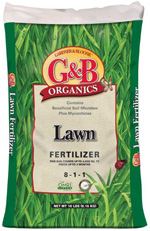|



Master Nursery Bumper Crop can be mixed with your native soil as a nutrient-rich amendment to grow vegetables and flowers, or can be used as an organic mulch to help retain water. With added beneficial mycorrhizae, worm castings, bat guano and kelp meal - and no harmful synthetic chemicals   
  |
 |
Featured Quote: "He who plants a tree loves others besides himself." |

Buy 3 Bags of |
 |
|
G&B Organics |
 |
|
Planting
Maintenance Duties
|
 |
|
If you have ever wondered how to get some of the same great flavors you find in top restaurants, consider planting the secret weapon that fine cooks employ--a chef's garden. Get the most out of your garden by adding not only beauty but an endless bounty of flavor as well! A good chef's garden incorporates the attributes of every location in the garden to produce a variety of flavorful food. Start with a boring fence line. Instead of flowering vines, consider attaching a few trellises and planting a variety of different table grapes. To block out the neighbor's windows and create privacy, plant fruit trees. You can harvest apricots and cherries in June; nectarines, peaches, plums and pluots in July and August; and apples, pears and persimmons in September and October. Semi-shaded areas are a great place to plant berries. If you have the room to allow them to roam, consider planting blackberries, boysenberries, and raspberries. Are you looking for something a little more formal? Consider blueberries. Save the sunniest location for your vegetable garden. Remember to plant "fruit" and "root" vegetables for summer. Plant "leaf" and "flower" vegetables in winter. Don't forget to add a little color with tasty nasturtiums--and save some space for a crop of strawberries, artichokes, and horseradish. Are you short on space? No problem. Herbs do wonderfully in containers--and no chef should be without them. You'd perhaps be surprised how many vegetables can also be grown in containers. And don't forget dwarf fruit trees! The key to creating a great chef's garden is to look at every available location in your garden with the eyes of a chef. The possibilities are endless and the rewards are delicious. Are you getting hungry, now? Then don't delay, start planning your chef's garden today. |
 |
|
Perhaps nothing heralds the coming of spring like the magnificent saucer-like flowers of the tulip magnolia (Magnolia x soulangeana), also known as saucer magnolia or Chinese magnolia. These small deciduous trees are one of the most popular trees in the home landscape, and when they bloom, they are truly extraordinary. There are many cultivars of this hybrid species with the 4-5" blossoms ranging in color from pure white to shades of pink and purple--and now even shades of yellow. The winter floral buds are large and fuzzy, giving rise to "candles" as they expand and open. In warm climates, this can be as early as January and February, but for most of the country, the flowers reveal themselves in late March and early April, before the foliage emerges. The flowers can be damaged by late frosts, so we plant the late-blooming varieties here. Most of these varieties have an upright oval growth habit in youth, becoming rounded, spreading, and mounding with age. They make great small trees, with some varieties growing up to 30' high. But most varieties can be maintained at 10-15' with yearly pruning. The 6" medium-to-dark green leaves hold their color right through the end of fall, before they drop for winter. They like moist, acidic, deep, and porous soils but can be quite adaptable to a wide range of conditions. They do best when transplanted in spring or summer into holes that have been amended with a good soil conditioner. We recommend covering the soil around the tree with a 2-3" layer of mulch to protect against weeds and for winter cold protection. |

|
When spring finally rolls around, it brings with it beautiful blossoms, fresh air, warmer temperatures...and bugs! Ants, gnats, aphids - none of which are pleasant. Ah, but spring also gives us ladybugs, which are the best-known garden predators available. There are nearly 5,000 different kinds of ladybugs worldwide, 400 of which live in North America. In fact, Delaware, Massachusetts, New Hampshire, Ohio and Tennessee have adopted the ladybug as their official state insect! As legend has it, in Europe, during the Middle Ages, the crops were being destroyed by insects, so the farmers prayed to the Virgin Mary for help. The ladybugs came, ate the pests, and saved the crops! The grateful farmers began calling the ladybugs "The Beetles of Our Lady" which eventually morphed into "Lady Beetles," and from there to ladybugs. With aphids, mealy bugs and mites being their favorite food, ladybugs are some of our most beneficial bugs; an adult ladybug can eat over 50 aphids a day. These small, oval-winged insects are usually red with black spots, and are less than ¼ inch in length. As they age, the color of the spots will fade. If a bird, the primary predator of the ladybug, threatens a ladybug, she will play dead. Some more silly facts about this delightful and advantageous visitor to our forests, fields, gardens, and yes, even our homes:
Ladybugs eat nectar as well as insects, so to attract and keep them, grow some of their favorite nectar plants - if you like growing herbs, try some dill, cilantro, fennel or yarrow. Flower growers, try cosmos,sweet alyssum, coreopsis, marigolds and geraniums. They also like lilies and other cup-shaped flowers to hide in. Get to know your beneficial insects. They can be very useful in keeping the pests away and reducing the use of chemicals. Consider adding some ladybugs to your garden this spring! And remember--when you do need to use chemicals in your garden, read the instructions carefully and consult with one of our nursery professionals, who can advise you on the best one to use for your particular problem. |

|
We all talk about the weather - but there is nothing we can do to change it! We've heard it for years and it's certainly true! While we can't turn nature's faucet on and off, we can help our garden take advantage of the extra "blessing" when we get overly generous amounts of water. Capture as much of the rain as you can with rain barrels to store the water! Natural rain provides essential nutrients not available in tap water. You'll see very happy plants when you water them with natural rain. You'll see a vigor and growth characteristic of a fertilization when you put them on a diet of natural rain. All this rain will also affect the garden. On the good side, you won't need to water for a while, and the natural rain is better for the garden, too. On the bad side, an abundance of winter rain will bring about an abundance of undesirable weeds in early spring. You can reduce the weed problem while preserving the moisture accumulated in the soil. This can be accomplished this by applying a pre-emergent weed preventer and then covering the soil with a 1-2 inch layer of mulch. Choose a material less likely to float out of the bed and onto the lawn or patio. The mulch will not only help prevent weeds but also help to retain much needed soil moisture in the summer months. |
 |
|
Daylight Saving Time begins at 2 am on Sunday, March 10, 2019, so be sure to set your clocks forward one hour! Your clocks should be set from 2:00 a.m. local standard time, to 3:00 a.m. local daylight time. We remember to change our clocks by the phrase "Spring forward, fall back." As spring begins soon, why not embrace this season of renewal, and replace the batteries in all of your smoke detectors and carbon monoxide detectors. This simple act will help assure the safety of your family; properly working detectors save thousands of lives each year. |

 |
Written content © Garden Partners LLC, or respective authors. All Rights Reserved. Privacy Policy. All written content contained in this site is protected by United States copyright law and may not be reproduced, distributed, transmitted, displayed, published, or broadcast without prior written permission of Garden Partners, LLC. You may not alter or remove any trademark, copyright or other notice from copies of the content. |



